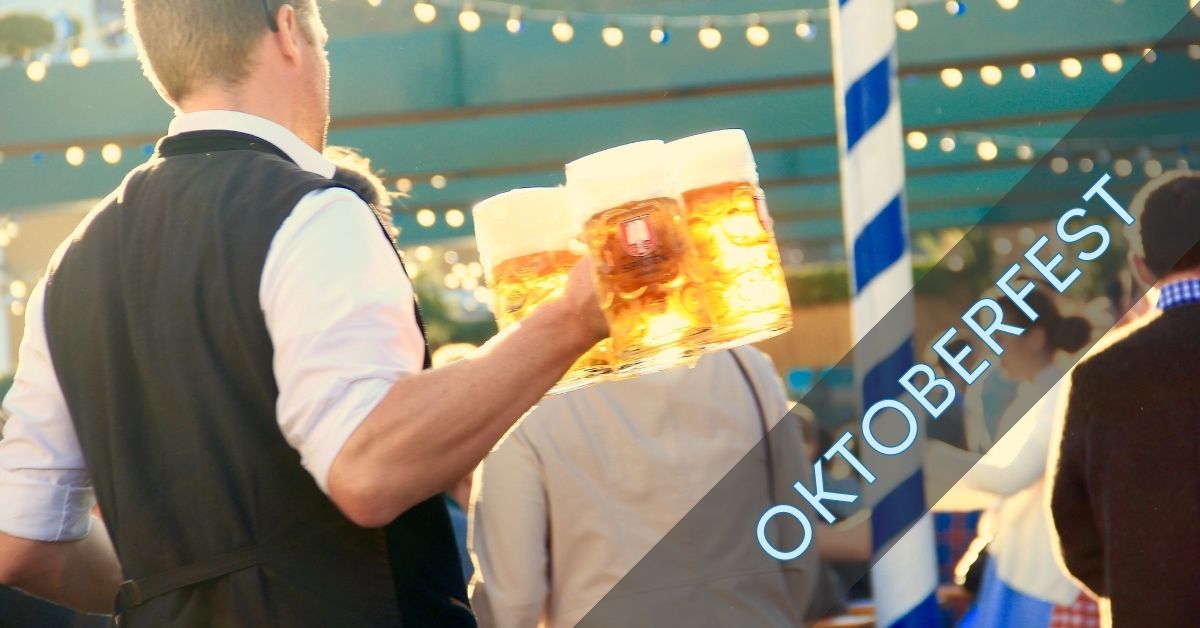- Home
- festivals in Germany
- oktoberfest in germany
The Best Oktoberfest in Germany
By: Lydia Fulson / Writer, Pyrography Artist, Thrill Seeker, and Traveler
When is Oktoberfest this year?
Oktoberfest 2025: The Theresienwiese fairgrounds in Munich from Sept 20 – Sun, Oct 5.
Get ready. Oktoberfest is coming!
O'zapft Is! 'It's tapped!' A celebratory motto chanted along with a 12-gun salute to mark the tapping of the first Oktoberfest beer keg, a tradition passed down since 1950.
I hope you're ready for some good ol' beer drinking, foot tapping, bratwurst munchin' fun!
On this page:
Welcome to the Best Oktoberfest in Germany!
Oktoberfest in Germany is a pretty big deal. People start making preparations for the big day months ahead of time. Last year's celebration ends, and the planning for next year begins.
There is no entry fee. Free admission only! Vouchers are available for food ahead of time, and of course, one has to pay for all the treats and drinks, but it's not one of those festivals that will leave holes in your pockets. That's what makes the Munich Oktoberfest so popular with tourists. It's cheap considering all of the entertainment given. Just wait until you hear the live music.
This festival is a huge part of German heritage. Among all of the hip-hoppity festivals in Germany, Oktoberfest trumps all. Hip-hoppity because there is guaranteed to be dancing, and lots of it. The uplifting polka bands put you right in the celebratory mood. This German tradition is full of fun, traditional styles, foods, and the best Oktoberfest beers for miles around.
The Very First Oktoberfest
Cue, “Here comes the bride.”
The famous festival all started with wedding bells in 1810 when Prince Ludwig I celebrated his new marriage with a festival like no other.
His trusted friend and national guard member had the brilliant idea of having a party with all of Munich's people, and then a grand horse race to follow. Little did the prince's guard know that this idea would go down in history books as Germany's biggest festival for centuries after!
The royal family invited the whole kingdom, along with fellow royals, and passed out free drinks to everyone who attended. Music, extravagant decoration, and loads of German treats were being passed around. The night ended with a horse race, one of the prince's favorite sports to watch.
 Ludwig declaring the celebration of a lifetime
Ludwig declaring the celebration of a lifetimeThis led to the people of Munich thinking up the brilliant realization of “Hey, this is fun. We should do this more often.”
Thus, the rise of the annual celebration. Well, there's a bit more to it than that, but that's how it all came to be! A lavish wedding with an overabundance of food and horses.
By the next year and the following few to come, the name Oktoberfest was born, and the dancing and horse racing were combined with fair games, beer tents, and live plays, making it even more festival-like.
Nowadays, there are beer halls, traditional costumes, food vendors a-plenty, German bands, Ferris wheels, gift shops, and lots of beer.
German Beer
Beer is a big part of Oktoberfest itself. After all, it is known for being the largest beer festival in the entire world. When people think of beer, they think of Germany.
Approximately 5.6 million liters of beer were poured at 2023's Oktoberfest celebration!
German beer is like no other. It's smooth and flavorful, and in some restaurants, it's even cheaper than water! I enjoyed a few in our time over the pond. The best part was, the closer we got to Munich, they just kept getting better and better.
 Prost! From Oma and I.
Prost! From Oma and I.Beer halls all over Munich are packed during the celebration. So if you're looking to get in, prepare to be standing and drinking or being packed like sardines at the tables inside.
More seating can be found outside the beer halls, with beer tents scattered about. When I say beer tents, I mean tents as big as you can possibly imagine. These are meant to hold thousands of people at a time.
Typically, for the celebration, at least 20 large tents are set up with close to 25 smaller ones. Every large tent has its own theme and is cleverly thought-out to host different parts of Bavarian history.
Themed Tents
A crowd favorite is the Armbrustschützenzelt tent, translating to “crossbow shooters' tent.” Things like this make Oktoberfest so much more than just a beer festival. In the Armbrustschützenzelt, guests can grab pints of their favorite beer and their best bow, and shoot the moving targets zooming by up above in the 30-meter shooting zone.
No, this wasn't invented by a bunch of drunken kids fooling around. It was actually made a tradition by a famous German crossbow guild, which in 1895, a tent was built after. The guild would hold a crossbow competition every year in the very spot where the official tent was built in honor of the fun newfound tradition.
 Now that's a crowd!
Now that's a crowd!This is just one of the themed tents to wander through (I use the term wander loosely … the sardine analogy was a real one.)
There are a famous handful of breweries that participate in serving and brewing for Oktoberfest every year, including family-owned breweries that have been favorites for centuries.
The Augustiner Bräu, founded in 1328, is the only brewery that, to this day, still uses the “hirsche,” traditional wooden barrels with a capacity of 200 liters. It's also the oldest brewery in Munich.
Hacker-Pschorr beer comes in the close first place, as it can be found in multiple beer tents at Oktoberfest. The Pschorr tent and Hacker tent are two large tents that carry this famous beer, along with many small tents as well. There truly is something for every beer drinker/lover here. If you like smooth, rich, or powerful flavors, or if you just want something to raise to join in the group cheers! ('Prost!')
 I spied with my little eye, a true beer hall in Munich!
I spied with my little eye, a true beer hall in Munich!In my photo above, you can see the traditional Bavarian checkered flag hoisted high and proud in front of the beer hall.
Making Beer Tent Reservations
Making reservations for a spot or group spot in the Oktoberfest tents is only sometimes necessary. Regardless of how packed they get, there are open seats and tables in large tents for the stragglers, tourists, and passersby. Some will even bring out spare tables if needed to accommodate more numbers.
In the smaller tents, there is a bit more of a limited space for the organizers to work with. So accommodating everyone can be challenging, especially during the evenings when the large groups come in to take in the live performances and refreshing beer steins.
One can call ahead of time to be sure that you and your party will have somewhere to sit, laugh and be merry as a group. How odd would it be to have everyone sitting in random spots in a pack of strangers you don't know? Though, those strangers are just trying to enjoy themselves among the chaos too. So if you do get separated from the pack during the seating, make the best of it. What fun it would be to come home from your travels in Germany and be able to say that you went to the famous Oktoberfest AND made the best of friends in one of the famous massive beer tents while being there.
What's up with the White and Blue?
You'll notice, of course, that everything is decorated in the traditional blue and white. Did you know that the white and blue colors come from the Bavarian flag? Two types of flags can be seen around Oktoberfest and Bavaria, and both are related to the old royal Bavarian family, the Wittelsbach's.
One has two horizontal stripes, one white and one blue. The other is patterned with white and blue rhombuses resembling a checkered pattern. This is the most common one to find during Oktoberfest celebrations. Its pattern is found on flagpoles, tablecloths, beer mugs, clothing, and just about everywhere. It's not the best Oktoberfest in Germany without the blue and white.
 The two flags of Bavaria. Which one do you see more of?
The two flags of Bavaria. Which one do you see more of?What To Wear to Oktoberfest: Traditional Bavarian Outfits
There are two main things one can expect to see at Oktoberfest celebrations. Beer ... and lederhosen.
That's right, and they're as fun as the word makes them sound. Lederhosen is the traditional outfit that the men wear in Bavaria, especially around Oktoberfest. The outfit consists of a pair of leather suspenders attached to a pair of leather shorts, sometimes decorated with designs and patterns. Don't forget the knee-high socks and Tyrolean hat. The Tyrolean is popular not only in Germany but Austria as well. This hat is a significant part of completing the men's celebration look. The feather is the cherry on top!
 Come to Oktoberfest dressed in your Bavarian best!
Come to Oktoberfest dressed in your Bavarian best!But what about us women? Don't worry. We get something snazzy too. A Dirndl is a traditional dress or skirt with a blouse and apron. How cute is that?
These dresses are absolutely beautiful and can be bought in Munich. You can also order online or buy them in the United States at Rare Dirndl. (You'll get $40US off your first dirndl if you use the code OMA40 at checkout!)
The poofy skirts make for the perfect twirl during the dancing! They may have been invented in the 18th century, but hey, they knew what they were doing because these Dirndls are still in style anywhere in Bavaria. People will wear them out and about, just because. Why not??
What's the Grub?
The annual festival hosts some crazy good grub to give you that unique experience you expect when visiting a festival like this. There's no better place to try the tried-and-true Bavarian classics than Oktoberfest itself.
Oktoberfest food is unmatched. The food trucks and tents carry traditional meat dishes like bratwurst with curry ketchup, roast chicken, pork chops, schnitzel, and the famous favorite, pork knuckle. Tarte flambée, dumplings, and red cabbage galore! Fill up your plates and dig in.
There's something so irresistible about Oktoberfest goodies. If you're looking to have your own Oktoberfest party from home, our Oma has the book for you! Her Oktoberfest eCookbook introduces the festive favorites and the easiest ways to make them.
All of these things together make for the best Oktoberfest in Germany. Who would want to miss this? Unless you're not one for crowds, then maybe hang around the fair rides and food stands. No one said you had to socialize at these things! Just have a good time!
Or visit a small local beer garden. The gardens are just like a mini Oktoberfest without the hustle, bustle and sardine packing.
With all of that, you know all you need to know to enjoy your festival journey.
Now go off to the Theresienwiese fairgrounds to munch away, drink merrily, dance with all your might, and have a blast.



